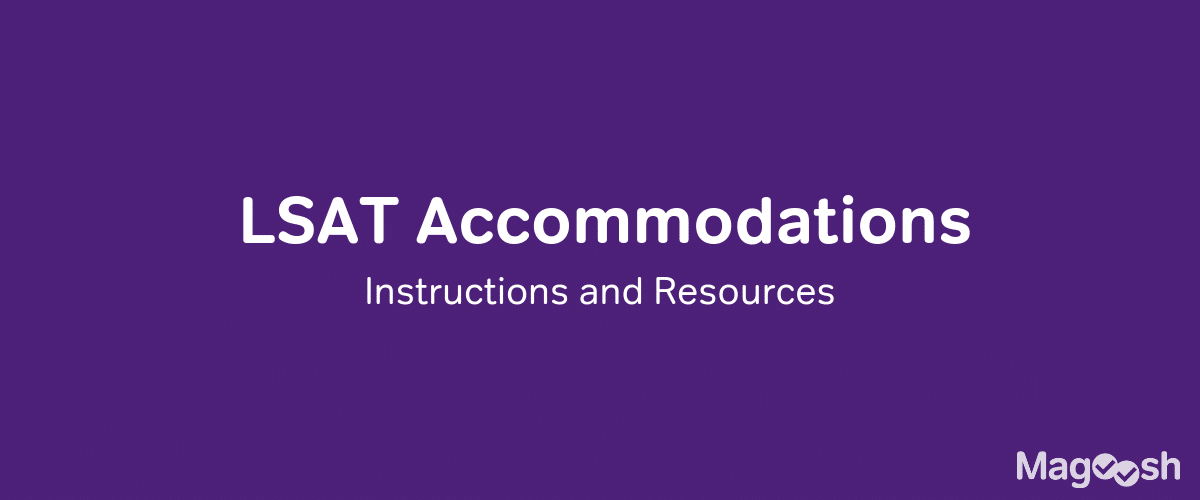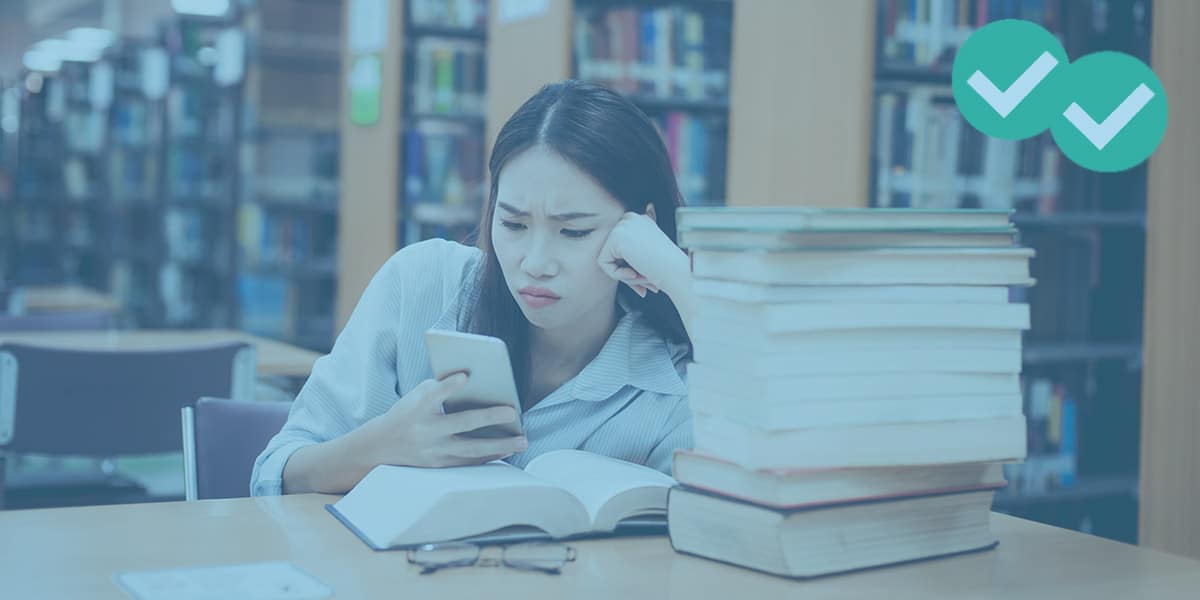
LSAC offers a variety of accommodations, including LSAT extra time. You can start by reviewing the options here: Accommodations That May Be Available on the LSAT.
To request LSAT accommodations, follow the steps from LSAC Policy on Accommodations for Test Takers with Disabilities, which are summarized here:
- Register for the LSAT online, by phone, or by submitting a paper registration form which you can get by calling 215.966.6625 or 855.384.2253 (toll-free). Note: You cannot request accommodations until you have registered.
- Make sure to review the policies and forms at the link above.
- You must register by the deadline listed here: LSAT Registration Dates & Deadlines.
What Accommodations are Available on the LSAT?
The LSAC provides a large list of possible accommodations for test-takers who qualify. This list includes everything from simple accommodations such as the use of earplugs or scratch paper, to more substantial accommodations, such as extended time or use of a scribe. LSAC emphasizes that its accommodation list isn’t exhaustive, so if you need a change that is not listed, you’ll have a chance to request it specifically.
Here’s a list of the most commonly requested LSAT accommodations:
- Unified English Braille (UEB) version of the LSAT
- Large print (18 pt.) test book
- Screen-readable HTML test (including, where applicable, use of screen reader software (e.g., JAWS))
- Extended test time up to double time
- Use of computer and printer for the Writing Sample
- Use of spell check
- Alternate non-Scantron answer sheet
- Use of a reader
- Use of an amanuensis (scribe)
- Additional rest time during breaks (standard break is 10–15 minutes between third and fourth sections)
- Breaks between sections
- Sit-stand with a podium
- Wheelchair accessibility (if table is requested, specify height)
- Separate room (e.g., small group testing)
- Private testing room (e.g., low-distraction setting)
- Stop-the-clock breaks
- Scratch paper
- Voice recognition software (e.g., Dragon)
- Physical prompts (e.g., for test takers with hearing impairments)
- Reserved or assigned seating location (e.g., seating near the exam proctor)
- Bring and eat food
- Permission to bring insulin, check blood sugar
- Permission to bring and take medications
- Earplugs
- Use of line marker
- Use of magnification devices (e.g., magnification reading glasses, handheld video magnifier, closed circuit
- television (CCTV), ZoomText)
- Ability to pace (walk around)
- Marking answer choices in the test book
- Book stand
Source: LSAC website
Applying for Accommodations That Do Not Require LSAT Extended Time
LSAC refers to applications for accommodations that do not require LSAT extra time as “Category #1 Requests.” If you seek one of these accommodations — such as permission the ability to take prescription medicine or check your blood sugar levels during the test — you’ll need to submit three items:
- Candidate Information Form
- Evidence of Disability
- Statement of Need for Accommodation.
LSAC’s website provides links to each of these forms.
Applying for LSAT Extra Time Accommodations
LSAC has two categories of requests for LSAT accommodations that require extended time:
- Category #2 refers to requests for up to 50% extended time for those who do not have a severe visual impairment, or for up to 100% extended time for those whose visual impairment requires an alternative test format.
- Category #3 refers to requests for more than 50% extended time for those who do not have a visual impairment, or for more than 100% extended time or those whose visual impairment requires an alternative test format.
Applications for Category #2 and Category #3 accommodations requests require the same paperwork as Category #1 requests: (1) Candidate Information Form, (2) Evidence of Disability, and (3) Statement of Need for Accommodation.
Will I have to document my disability when applying for LSAT accommodations?
Unless you qualify based on accommodations you received on a prior standardized test, you’ll need to document your disability. In many cases, you can use documentation that demonstrates accommodations you received in the past. For example, if in the past five years you were examined for an approved Individualized Education Plan or Section 504 Plan, you can rely on that documentation for your application.
You can still apply for accommodations on the LSAT even if you haven’t previously received educational accommodations. You will, however, need to provide full current documentation of your disability, including an evaluation from a qualified professional. LSAC explains this fully in its Evidence of Disability Form. Note that you can apply for accommodations even if your disability is temporary, such as an injury to your hand.
You will also need to provide a rationale for receiving testing accommodations. This is what LSAC calls the Statement of Need. You can follow LSAC’s directions to explain why your situation requires accommodations. In some cases, it will be best to supplement the rationale you provide with an additional statement from a qualified professional who has evaluated your need.
Appealing LSAC’S Denial of Your LSAT Accommodations Request
If LSAC denies your accommodations request, you can appeal. However, the turnaround time for your appeal is short. You have just 24 hours from the time that LSAC posts its decision to your online LSAC account to provide notification of your intent to appeal. You will complete this notification through your online LSAC account. You then have just four days from the day that LSAC posts its decision to submit your actual appeal. LSAC will make a decision on your appeal within one week of the day that you submit your appeal.
How do I apply for LSAT accommodations?
If you have never applied for LSAT accommodations before, please review the following instructions:
- Accommodations That May Be Available on the LSAT
- Documentation Requirements
- Policy on Prior Testing Accommodations on Certain Other Standardized Postsecondary Admission Tests
- Procedures & Policies on the Use of Readers on the LSAT
- Common Reasons Why Documentation Is Deemed Insufficient by LSAC
- Appeal Procedures for Accommodation Requests
- Frequently Asked Questions
You will need to fill out the following forms:
I’ve applied for LSAT accommodations before. What happens next?
If you’ve received accommodations in the past, you will be approved for future exams.
- Candidates who were approved in the past will be approved for the LSAT Writing sample, which will be administered separately starting in June 2019. For example, students given LSAT extra time or Braille will also get extra time or Braille on LSAT Writing.
- Students can review the policy here: Testing Accommodations on the July 2019 LSAT Administration.
- Students who had previous approval on a paper version of the test will be given the same accommodations on the digital LSAT beginning in September 2019.
- If your past registration was approved and you now need additional accommodations, you’ll need to apply again, using these forms:
- If your last LSAT registration was more than five years before the current test, or if you’re unsure of whether your specific accommodation will be possible or approved on a future version of the LSAT, be sure to contact an LSAC Accommodated Testing Customer Relations Specialist by phone at 215.966.6625 or 855.384.2253 (toll-free), or by email at [email protected].
Contact Info
Please allow 14 business days for a response from LSAC about LSAT accommodations.
Email, Phone, and Fax
Email (General): [email protected]
Email (Accommodated Testing Complaints): [email protected]
Phone: 215.966.6625
Toll-free: 855.384.2253
Fax: 215.504.1420
US mail address:
LSAC Accommodated Testing
PO BOX 8512
Newtown PA 18940-8512
USA
Courier address:
LSAC Accommodated Testing
662 Penn Street
Newtown PA 18940-0995
USA
NOTE: Special thanks to Matthew Slayton in Magoosh Student Help and my fellow Magoosh LSAT blogger Sean Cooke for doing the initial research and assisting with the writing.




![Magoosh LSAT Prep with Official LSAC Prep Integration [HUGE Announcement!]](https://magoosh.com/lsat/files/2020/03/LSAT-new-plan-button.png)

